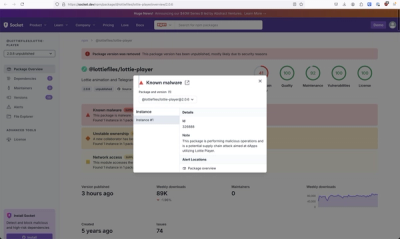Swagger JS library

This is the Swagger javascript client for use with swagger enabled APIs.
It's written in javascript and tested with mocha, and is the fastest way to enable a javascript client to communicate with a swagger-enabled server.
Check out Swagger-Spec for additional information about the Swagger project, including additional libraries with support for other languages and more.
Calling an API with swagger + node.js!
Install swagger-client:
npm install swagger-client
or:
bower install swagger-js
Then let swagger do the work!
var Swagger = require('swagger-client');
var client = new Swagger({
url: 'http://petstore.swagger.io/v2/swagger.json',
success: function() {
client.pet.getPetById({petId:7},{responseContentType: 'application/json'},function(pet){
console.log('pet', pet);
});
}
});
NOTE: we're explicitly setting the responseContentType, because we don't want you getting stuck when
there is more than one content type available.
That's it! You'll get a JSON response with the default callback handler:
{
"id": 1,
"category": {
"id": 2,
"name": "Cats"
},
"name": "Cat 1",
"photoUrls": [
"url1",
"url2"
],
"tags": [
{
"id": 1,
"name": "tag1"
},
{
"id": 2,
"name": "tag2"
}
],
"status": "available"
}
Handling success and failures
You need to pass success and error functions to do anything reasonable with the responses:
var Swagger = require('swagger-client');
var client = new Swagger({
url: 'http://petstore.swagger.io/v2/swagger.json',
success: function() {
client.pet.getPetById({petId:7}, function(success){
console.log('succeeded and returned this object: ' + success.obj);
},
function(error) {
console.log('failed with the following: ' + error.statusText);
});
}
});
You can use promises, too, by passing the usePromise: true option:
var Swagger = require('swagger-client');
new Swagger({
url: 'http://petstore.swagger.io/v2/swagger.json',
usePromise: true
})
.then(function(client) {
client.pet.getPetById({petId:7})
.then(function(pet) {
console.log(pet.obj);
})
.catch(function(error) {
console.log('Oops! failed with message: ' + error.statusText);
});
});
Need to pass an API key? Configure one in your client instance as a query string:
client.clientAuthorizations.add("apiKey", new Swagger.ApiKeyAuthorization("api_key","special-key","query"));
...or with a header:
client.clientAuthorizations.add("apiKey", new Swagger.ApiKeyAuthorization("api_key","special-key","header"));
...or with the swagger-client constructor:
var client = new Swagger({
url: 'http://example.com/spec.json',
success: function() {},
authorizations : {
easyapi_basic: new Swagger.PasswordAuthorization('<username>', '<password>'),
someHeaderAuth: new Swagger.ApiKeyAuthorization('<nameOfHeader>', '<value>', 'header'),
someQueryAuth: new Swagger.ApiKeyAuthorization('<nameOfQueryKey>', '<value>', 'query'),
someCookieAuth: new Swagger.CookieAuthorization('<cookie>'),
}
});
Note the authorization nickname, such as easyapi_basic in the above example, must match the security requirement in the specification (see the OAI Specification for details).
You can also pass authorzations on a per-request basis, in the event that you're reusing a swagger-client object across multiple connections:
client.pet.addPet({pet: {
name: 'doggie'
}}, {
clientAuthorizations: {
api_key: new Swagger.ApiKeyAuthorization('foo', 'bar', 'header')
}
})
.then(function(pet) {
console.log(pet.obj);
});
Calling an API with swagger + the browser!
Download browser/swagger-client.min.js and place it into your webapp:
<script src='browser/swagger-client.js' type='text/javascript'></script>
<script type="text/javascript">
window.client = new SwaggerClient({
url: "http://petstore.swagger.io/v2/swagger.json",
success: function() {
client.pet.getPetById({petId:1},{responseContentType: 'application/json'}, function(data) {
document.getElementById("mydata").innerHTML = JSON.stringify(data.obj);
});
}
});
</script>
<body>
<div id="mydata"></div>
</body>
Need to send an object to your API via POST or PUT?
var pet = {
id: 100,
name: "dog"};
client.pet.addPet({body: pet});
Sending XML in as a payload to your API?
var pet = "<Pet><id>2</id><name>monster</name></Pet>";
client.pet.addPet({body: pet}, {requestContentType:"application/xml"});
Need XML response? (assuming your server can produce it)
client.pet.getPetById({petId:1}, {responseContentType:"application/xml"});
Custom request signing
You can easily write your own request signing code for Swagger. For example:
var CustomRequestSigner = function(name) {
this.name = name;
};
CustomRequestSigner.prototype.apply = function(obj, authorizations) {
var hashFunction = this._btoa;
var hash = hashFunction(obj.url);
obj.headers["signature"] = hash;
return true;
};
In the above simple example, we're creating a new request signer that simply
Base64 encodes the URL. Of course you'd do something more sophisticated, but
after encoding it, a header called signature is set before sending the request.
You can add it to the swagger-client like such:
client.clientAuthorizations.add('my-auth', new CustomRequestSigner());
Using your own HTTP client
Don't like superagent? Despise JQuery? Well, you're in luck. You can plug your own HTTP library easily:
var myHttpClient = {
execute: function(obj) {
var httpMethod = obj.method;
var requestHeaders = obj.headers;
var body = obj.body;
var url = obj.url;
if(itWorked) {
obj.on.response('horray');
}
else {
obj.on.error('boo');
}
}
};
var client = new SwaggerClient({
spec: petstoreRaw,
client: myHttpClient,
success: function () {
client.pet.getPetById({petId: 3}, function(data){
expect(data).toBe('ok');
done();
});
}
});
How does it work?
The swagger javascript client reads the swagger api definition directly from the server. As it does, it constructs a client based on the api definition, which means it is completely dynamic. It even reads the api text descriptions (which are intended for humans!) and provides help if you need it:
s.apis.pet.getPetById.help()
'* petId (required) - ID of pet that needs to be fetched'
The HTTP requests themselves are handled by the excellent superagent library, which has a ton of features itself. But it runs on both node and the browser.
Development
Please fork the code and help us improve swagger-js. Send us a pull request to the master branch! Tests make merges get accepted more quickly.
Note! We will not merge pull requests for features not supported in the OAI Specification! Add an issue there instead!
swagger-js use gulp for Node.js.
npm install -g gulp
npm install
gulp -T
gulp
gulp test
gulp build
gulp watch
gulp lint
gulp coverage
License
Copyright 2016 SmartBear Software
Licensed under the Apache License, Version 2.0 (the "License");
you may not use this file except in compliance with the License.
You may obtain a copy of the License at
apache.org/licenses/LICENSE-2.0
Unless required by applicable law or agreed to in writing, software
distributed under the License is distributed on an "AS IS" BASIS,
WITHOUT WARRANTIES OR CONDITIONS OF ANY KIND, either express or implied.
See the License for the specific language governing permissions and
limitations under the License.





